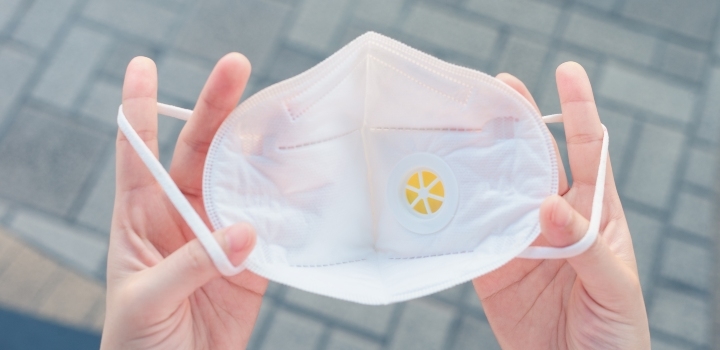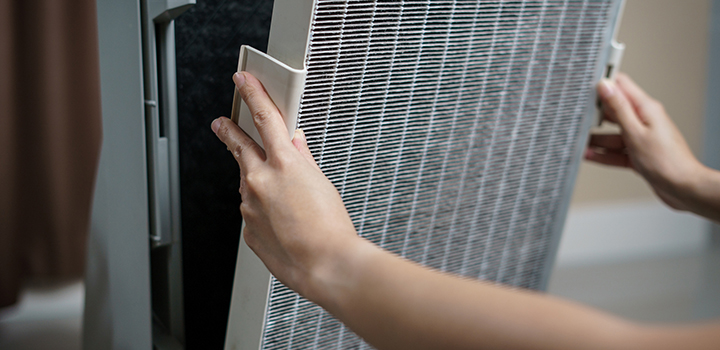Face masks could protect vulnerable people against Coronavirus
By: News Archive

Wearing a face-mask while out-and-about on public transport, in shops and in crowded places could help protect vulnerable people from COVID-19 – according to a new systematic review from the University of East Anglia.
However, the researchers say the evidence is not strong enough to recommend widespread use of masks in the general population.
Researchers studied all existing data about whether using a face-mask reduces the spread of illnesses with COVID-19-like symptoms such as fever and cough/sore throat or other respiratory infection symptoms.
They found 31 studies that had analysed whether wearing face masks stopped people getting symptoms. The UEA researchers found that masks had a consistent but small protective effect – particularly in shared public spaces.
While the evidence is not strong enough to recommend widespread use of masks in the general population, the researchers say that there is enough evidence to support vulnerable people deciding to use them for short periods when in temporary higher risk situations – such as on public transport, visiting shops or in healthcare settings.
Due to the rapid-response nature of this research, it has not yet been peer-reviewed.
Study author Prof Paul Hunter from UEA’s Norwich Medical School, and an expert in infectious diseases, said: “There has been a lot of debate about whether wearing a face-mask could help protect people from COVID-19 and reduce the spread of the disease.
“We wanted to evaluate all the available evidence to see what the best-advice for people is.
“We studied when respiratory symptoms appeared that were similar to COVID-19 - fever and cough or sore throat. But it’s important to remember that we have not been able to look specifically at COVID-19 because there have been no specific studies to date.”
Lead researcher Dr Julii Brainard, also from UEA’s Norwich Medical School, said: “We found that using a face mask and other face coverings had a consistent but small protective effect against influenza-type symptoms while people are out-and-about in the community.
“People who wore masks, usually surgical grade, were less likely to get respiratory symptoms from casual exposure in the community. Something like a sneeze or cough near you would become less likely to cause infection. It’s a small reduction in risk, but might be very important to especially vulnerable people.
“Wearing masks at home also seemed to reduce the odds of well housemates become ill. The risk reduction was greatest, a 19 per cent reduction, if both an ill person and their well contacts wore masks.
“The protective effect is probably small within a home setting because people have lots of repeated types of contact, so there are many ways for the germs to transmit. This is why washing hands remains so important. Washing hands well only requires 20 seconds of concentration occasionally throughout the day.
“In contrast, it is difficult to wear masks correctly for many hours over many days. They can be uncomfortable, hot, cause skin reactions or simply feel anti-social. Masks also need to be disposed of correctly to prevent transmission.
“And of course, wearing a mask interferes with things like sleep, eating and brushing teeth. It’s impossible to keep them on all the time.
“We found that wearing face masks was also not that protective during large gatherings. But something to consider is that the only studies available on mass events were based on people attending the Islamic Hajj pilgrimage to Mecca, Saudi Arabia – which is especially large and crowded and lasts for many days. It may not be comparable to other large group gatherings.
“Overall, we found that the evidence was too uncertain to support the widespread use of face masks as a protective measure against COVID-19. However there is enough evidence to endorse the use of face masks for short periods of time by vulnerable individuals when in transient higher risk situations – such as on public transport or visiting shops.
“Although we can support vulnerable people who choose to wear masks to avoid infection, we want to remind everyone that the people who most need to wear masks, to protect us all, are health care workers. We are all in more danger from COVID-19 if health care workers cannot obtain the safety equipment they need, which could happen if community demand for face masks becomes too high.”
‘Facemasks and similar barriers to prevent respiratory illness such as COVID-19: A rapid systematic review’ is published on the preprint server MedRvix, on April 6, 2020.
Frequently asked questions, based on this research
Should we all be wearing masks?
No. Overall, the study found that the evidence was too uncertain and the possible protective effects too small to recommend widespread use of facemasks to protect against COVID-19.
For the general population – the best way to protect yourself and others is to follow the government guidelines for social distance and wash your hands regularly.
Masks are currently in very short supply and it is important that the people who are most at risk of catching the infection and possibly spreading it to others are health care workers. We are all in danger if doctors and nurses can’t wear masks because the general public bought up all available supplies.
What about vulnerable people?
The best way for vulnerable people to stay protected is to follow the government’s guidelines on self-isolation.
However, there is enough evidence to endorse the use of facemasks for short periods of time by vulnerable individuals when in transient higher risk situations – such as on crowded public transport or visiting busy shops.
Should I wear a mask for appointments at doctors surgeries, hospitals, dentists, or when visiting a pharmacy?
If these are not crowded environments then there is little chance of protecting yourself by wearing a mask. If you do have symptoms of respiratory illness, then wearing a mask could help protect others from your germs, especially if the place is crowded.
What about frontline NHS staff and carers?
The people who most need to wear masks, to protect us all, are health care workers dealing with possibly infectious patients. We are all in more danger from COVID-19 if health care workers cannot obtain the safety equipment they need. This could happen if community demand for facemasks becomes too high.
When should face masks be worn?
Wearing a facemask while out-and-about on busy public transport, in shops and other crowded places could help protect people from respiratory infections like COVID-19.
The study conclusions are that people who wore masks, usually surgical grade, were less likely to get respiratory symptoms from casual exposure in the community. Something like a sneeze or cough near you would become less likely to cause infection.
It’s a small reduction in risk, but it might be important to especially vulnerable people who may choose to wear facemasks.
Masks are currently in very short supply and it is important that the people who are most at risk of catching the infection and possibly spreading it to others, especially doctors and nurses, are not stopped from wearing them because supplies have run out due to the general public buying up available supplies.
We also need to remind everyone that the reduction in risk from wearing a mask may be fairly small. So people need to be vigilant about all their habits, and not rely on facemasks.
What about at home?
Wearing masks at home seemed to reduce the odds of well housemates become ill. The risk reduction was greatest, at 19 per cent, if both an ill person and the well people in the home wore masks.
The protective effect is not large within a home setting because people have lots of repeated types of contact, so there are many ways for the germs to transmit.
Also, it’s hard to wear masks correctly for many days at home. Wearing a mask correctly is difficult because masks interfere with things like sleep, eating and brushing teeth. It’s usually unrealistic to keep them on all the time. They can be uncomfortable, hot, cause skin reactions or simply feel anti-social. Masks also need to be disposed of correctly to prevent transmission. Most of the original controlled experiments reported that people who were assigned in the experiment to wear masks most of the time found this difficult.
This is why washing hands remains so important. Washing hands well only requires 20 seconds of concentration occasionally throughout the day. In contrast, it is difficult to wear masks correctly for many hours over many days.
What’s the correct way to use a face mask?
It actually depends on the design of the mask and what kinds of activities you have been doing. Each mask comes with its own instructions. A very general rule would be to assume a mask is no longer protective after wearing it for three hours. Wearers should wash their hands before they put on a mask, and importantly after they take it off and dispose of it.
What about non disposable masks (eg made from cloth, and veils?)
Face veils did not prevent developing respiratory symptoms at the Hajj (a very large annual religious mass gathering). But surgical masks weren’t that protective at the Hajj, either. There is no evidence about whether other types of cloth face coverings have ever helped to prevent respiratory infections when worn by ordinary people doing ordinary activities. In laboratory experiments, the cloth alternatives didn’t seem to perform as well as surgical masks could to stop transmission droplets.
Are disposable respirator masks much better than surgical masks?
In lab experiments or when health professionals wear them: Yes. When people in households and the community wore inexpensive respirators, the respirators were only about as protective as an ordinary surgical mask. Wearing a respirator correctly is harder than wearing a surgical mask correctly. There’s probably no advantage to wearing a respirator if it hasn’t been fitted correctly to your individual face.
What about using masks for large gatherings?
The study found that wearing facemasks was not that protective during large gatherings.
However the only studies available on mass events were based on people attending the Islamic Hajj pilgrimage to Mecca, Saudi Arabia – which is especially large and crowded and lasts for many days. It may not be comparable to other large group gatherings.
Related Articles

Air cleaners don’t stop you getting sick, research shows
Air filtration systems do not reduce the risk of picking up viral infections, according to new research from the University of East Anglia.
Read more
Wearable technology orthopaedic research shortlisted for national award
A project to support patients with their hip and knee replacement recovery using wearable technology has been shortlisted for a national innovation award.
Read more
Six UEA professors named in Highly Cited Researchers 2023 list
Six UEA professors have been named in the annual Highly Cited Researchers list for 2023, which celebrates some of the most influential researchers in the world today.
Read more